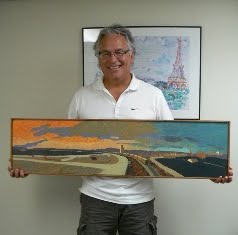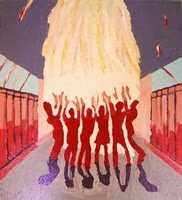i remember the idea. keep the visual arts fresh when we gather to meet. a noble premise. however, the fresh thing was not about longevity. marxie was keen on that. he held that people needed to be open-minded when newness happened in life. or within the church.
that said, i heard a lament in my brother's voice, when he learned that a wood and glass mosaic that he and his father had labored over one summer -- had been taken down during a church renovation. he now could identify with the feeling of loss with the approach of the new.
An engineer himself at the University of Nebraska

Lincoln, Paul Marxhausen. son of Reinhold Marxhausen, recounts the tabernacle mosaic he helped build one summer while he was in college. In part one he shares about the adhesives that were used. Two minutes.
Paul Marxhausen (PM): Work was not just the mural. It was over the top of the tabernacle, where they keep the host, the consecrated host. It is sort of like a sacred place, a sacred storage thing.
Karl Marxhausen (KM): Sure.
PM: Given the importance that they place on Christ's real presence in the host. So, yes, very dramatic.

KM: You said, there was like, little pieces of wood, you just had a whole bunch of little pieces...
PM: Yes, on the top, little fragments of wood, that started short in front and then worked their way up, kind of like a wave going up on to the wall, and then joining the wood...
KM: So, you had to figure out how to do that. Did Dad just say, "Here. Do that."
PM: That. I'm pretty sure he did that.
PM: I was involved with the pieces toward the top. Mostly pieces of wood - the conventional - for him...
KM: Yes.
PM: Going, pieces down on a flat board. He did a lot of experimenting with adhesives too. Because we were just going to GLUE TO THE WALL!! We were NOT going to be bolting.

PM: So, we got a bunch of different paneling pieces and TRIED them, TESTED them to destruction. "ok, this is the one, THE ONE that's going to WORK!"

KM: (laughter) (pause) So, that whole thing was in sections?
PM: Yes. He was able to do it

in sections, as was his USUAL PROCEDURE with wall murals. You know, to put it on a piece of plywood, build it, and then go install it.
Paul added in an email to me:
It *was* glued to the wall, the great majority of it. I can't help
thinking he *might* have put four anchor bolts into the cabinet at
the bottom, because it levers out from the wall and had, I think, a
metal cabinet in it. But all the rest of it was the plywood backing
glued directly to the wall. The wall had some degree of textured
surfacing sprayed on it, so we scraped it smooth so we would have
the best surface to glue to. (from email Nov 13, 2014)
The conversation continues remembering the summer he helped his father install a very tall mural. A scaffold that went up the the ceiling. Four minutes.

Paul Marxhausen (PM): Well, that was just a summer job. Dad had that commission, and it was summer time and I was at college, and so, sure I can do this.

PM: You know, as you remember, he had you and me working on the "wood part of stuff" all the time, he had kind of sketched out. And it was a good way to spend a whole summer with Dad. So, I got to help fabricate it, burn it, and then install it.

Which involved climbing up on scaffold, that was really tall!! I recall, I dropped his camera from the very top of the scaffold all the way to the floor and it didn't destroy it.
PM: Flabbergasted to see them take it out after such a short time.
KM: Well, I saw it stretched

out in that photo on the lawn, the north lawn. That it was almost the whole length of the north lawn. It was such a long piece.
PM: It was a very very tall piece. A very striking piece.
KM: So, did they require then, were they

specific about wanting something that would go that tall??
PM: Yeah, it was, it was to go, it was the width of a structural element in that room. And so it just goes up the side of that. Very much meant for that space.
PM: It did make me think, you know when they were moving from the "old Saint Johns" in Seward, the old traditional church, to the new church, you know. And I was "a kid." And I didn't have a lot of "sympathy" for the people, who were pining for the "old" art work and the "old" atmosphere of the church. "That's going to be torn down. What a shame! That's terrible," you know. "Yeah, yeah. Get with it." Well NOW, I kind of, (laughs) HAVE more sympathy. Something that I was INVOLVED with!! And now, someone has decided that it's OUT OF DATE and moved it out of their sanctuary and put it some place else.
KM: That was one huge piece. A lot of glass.
PM: Yep.
KM: And he also did an altar piece.
PM: Yes, there's a thing across the front of the altar. Which translates okay to putting on a wall some place, but, the taking it down off there... (shakes his head)
PM: At the time too, when we were putting it in, you had this nice new sanctuary, they were putting these new modern things in there. But there was also these two things that had these kitschy plaster statues of Saint Joseph and Saint Mary.
KM:Sure.

PM: And they said, "Well, Father says, you know, THOSE HAVE to be IN HERE too!! You know, we got to have that!!!" (shakes his head) They really look out of place. That's the danger of the catholic aesthetic, I guess, when it comes to worship [sacred] art, there is an element of tradition that is more important necessarily than the artistic.
KM: Sure.
KM: About how much time did that take? All summer?
PM: Yep. It took all of that, two or three months. That was my whole summer job.
KM: What was it like being on the scaffold?
PM: Dad was glad that I was there!!! It didn't bother me so much. We latched up pretty good, considering I usually have a fear of heights. Because we were right up to the ceiling!!
KM: That was like, what? Forty? Fifty?
PM: Yeah.
KM: ..feet up there.
PM: Straight up.




































































